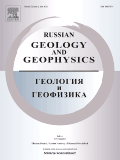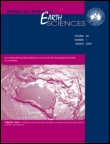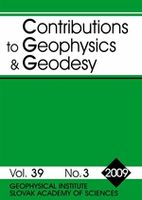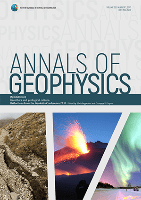
Exploration Geophysics
Scope & Guideline
Pioneering Insights for Sustainable Resource Exploration
Introduction
Aims and Scopes
- Geophysical Methodologies:
The journal covers a broad range of geophysical methods including seismic, electromagnetic, and magnetotelluric techniques, emphasizing advancements in data acquisition and processing. - Data Interpretation and Modeling:
A significant focus is on the development of new algorithms and models for interpreting complex geophysical data, including the use of machine learning and statistical methods. - Resource Exploration:
The journal highlights research related to the exploration of natural resources such as minerals, hydrocarbons, and geothermal energy, often integrating geological and geophysical data. - Environmental Applications:
Papers often address the application of geophysical methods in environmental studies, including groundwater exploration and contamination assessment. - Archaeological Geophysics:
The journal includes studies that apply geophysical techniques to archaeological investigations, showcasing the interdisciplinary nature of geophysics.
Trending and Emerging
- Machine Learning and AI Integration:
An increasing number of publications explore the application of machine learning and artificial intelligence in geophysical data processing and interpretation, reflecting a broader trend in the field towards data-driven methodologies. - Advanced Imaging Techniques:
There is a growing emphasis on sophisticated imaging techniques, such as full-waveform inversion and advanced tomographic methods, showcasing the journal's commitment to cutting-edge research. - Multi-Method Approaches:
Recent articles demonstrate a trend towards integrating multiple geophysical methods to enhance the accuracy and reliability of subsurface imaging and characterization. - Environmental Geophysics:
Papers addressing environmental issues, including groundwater assessment and contamination studies, are becoming increasingly prominent, highlighting the societal relevance of geophysical research. - Geophysical Applications in Archaeology:
The application of geophysical techniques in archaeological contexts is gaining traction, indicating an expanding interdisciplinary approach within the journal.
Declining or Waning
- Traditional Seismic Techniques:
There is a noticeable decline in research focusing solely on conventional seismic methods, as recent publications increasingly emphasize advanced processing techniques and integration with other data types. - Basic Geophysical Surveys:
Papers centered on foundational geophysical surveys with minimal technological innovation have decreased, suggesting a shift towards more complex and integrated approaches. - Static Data Interpretation:
Research that relies on static interpretations of geophysical data without incorporating dynamic modeling or real-time analysis has become less prevalent.
Similar Journals

Russian Geology and Geophysics
Advancing Earth Sciences through Rigorous ResearchRussian Geology and Geophysics is a seminal journal published by GEOSCIENCEWORLD that plays a pivotal role in the dissemination of vital research within the realms of Earth-Surface Processes, Geology, and Geophysics. With an ISSN of 1068-7971 and an E-ISSN of 1878-030X, this journal has witnessed a continuous evolution since its convergence in 2007 and is poised to thrive through 2024. While it is not an Open Access journal, it is recognized for its significant contributions to the academic community, holding a respectable Q2 ranking in Earth-Surface Processes and Q3 rankings in both Geology and Geophysics as of 2023. The journal’s impact factors align it within competitive quartiles, marking it as an essential resource for researchers and professionals seeking to stay at the forefront of geological and geophysical sciences. By publishing high-quality peer-reviewed articles, the journal fosters an environment of knowledge sharing and innovation, making it indispensable for students, practitioners, and scholars alike who are dedicated to advancing our understanding of Earth's complex systems.

AUSTRALIAN JOURNAL OF EARTH SCIENCES
Connecting Scholars through Earth Science DiscoveryAustralian Journal of Earth Sciences, published by Taylor & Francis Ltd, has established itself as a leading journal in the field of Earth and Planetary Sciences since its inception in 1984. With an impactful reach reflected in its ranking as Q2 in the Earth and Planetary Sciences category, the journal contributes significantly to the advancement of knowledge through rigorous peer-reviewed research. While it is not Open Access, the journal ensures broad accessibility through institutional subscriptions and various academic platforms. With a commitment to covering diverse topics within the Earth sciences, including geosciences, geology, and environmental studies, the Australian Journal of Earth Sciences is an essential resource for researchers, professionals, and students seeking to deepen their understanding of the dynamic processes that shape our planet. Engaging with the journal means being part of a vibrant community that aspires to push the boundaries of scientific inquiry and innovation in Earth sciences.

STUDIA GEOPHYSICA ET GEODAETICA
Connecting Scholars in the Realm of Earth SciencesSTUDIA GEOPHYSICA ET GEODAETICA, published by Springer, is a prestigious scientific journal that has been at the forefront of the fields of Geochemistry, Petrology, and Geophysics since its inception in 1957. With an ISSN of 0039-3169 and an E-ISSN of 1573-1626, the journal serves as a vital platform for disseminating original research and reviews that enhance our understanding of the Earth’s processes. Situated in the Netherlands, the journal is indexed in notable databases, holding a respectable Tier Q3 ranking in both Geochemistry and Petrology, as well as Geophysics, based on the 2023 metrics. With its commitment to academic rigor, the journal seeks to engage a diverse audience of researchers, professionals, and students, facilitating vital discourse and advancements in Earth sciences. Although it does not currently offer open access options, it remains a significant resource for those aiming to contribute to or further their knowledge within these critical disciplines.

Contributions to Geophysics and Geodesy
Connecting Scholars to Transform Geophysical UnderstandingContributions to Geophysics and Geodesy is a distinguished open access journal dedicated to advancing the field of geophysics and geodesy, published by the SLOVAK ACADEMY OF SCIENCES, EARTH SCIENCE INSTITUTE. With a rich publication history since its inception in 1992 and a commitment to open access since 2009, this journal serves as a vital platform for disseminating innovative research and critical insights in Earth sciences. Although it currently holds a Q4 ranking in the Geophysics category and is positioned in the 29th percentile, it continues to foster scholarly dialogue and enhance the visibility of significant findings in the community. Situated in Slovakia, the journal's address underscores its international reach and relevance. Researchers, professionals, and students alike will find valuable resources and perspectives within its pages, aiming to bridge gaps in knowledge and contribute meaningfully to the ongoing global discourse in geophysical sciences.

Geophysics and Geophysical Exploration
Advancing Earth Science Through Innovative Geophysical ResearchGeophysics and Geophysical Exploration is a prestigious journal dedicated to advancing the fields of geophysics and geophysical exploration. Published by the Korean Society of Earth & Exploration Geophysicists, this journal serves as a vital platform for researchers, professionals, and students to share innovative findings and developments in geophysical methods and technologies. The journal covers a broad range of topics including but not limited to seismic analysis, subsurface modeling, and remote sensing techniques, aimed at addressing the complex challenges in Earth science exploration. Although it does not currently offer open access options, the journal maintains rigorous peer-review standards, ensuring high-quality and impactful research contributions. With its commitment to fostering knowledge exchange in the geophysical community, Geophysics and Geophysical Exploration plays a critical role in enhancing our understanding of the Earth, making it an essential resource for those interested in geoscience and related fields.

Near Surface Geophysics
Exploring the Depths of Innovation in GeophysicsNear Surface Geophysics is a prominent journal published by WILEY, dedicated to the field of geophysics, particularly focusing on the innovative methodologies and techniques for subsurface exploration. With its ISSN 1569-4445 and E-ISSN 1873-0604, the journal has established itself as a reputable source of valuable research since its inception in 2003. The journal is currently ranked in the Q2 category within geophysics, reflecting its significant contribution to the discipline, and boasts a commendable Scopus ranking, placing it at #57 out of 165 in Earth and Planetary Sciences. Aimed at researchers, professionals, and students alike, Near Surface Geophysics provides a platform for disseminating high-quality research that enhances our understanding of subsurface processes and applications, making it an essential resource for anyone involved in geophysical studies. Although it does not currently offer open access options, its dedication to advancing geophysical science continues to resonate strongly within the academic community.

GEOSCIENCES JOURNAL
Pioneering Insights into Earth's Complex Systems.Welcome to the GEOSCIENCES JOURNAL, a pivotal publication in the fields of Earth and Planetary Sciences and Environmental Science, proudly presented by the Geological Society of Korea. Established in 1997, this journal has become a prominent platform for researchers, professionals, and students, offering a rich collection of peer-reviewed articles that explore a diverse array of geoscientific topics. With an impressive Q2 ranking in both Earth and Planetary Sciences and Environmental Science categories for 2023, it stands as an essential resource in the academic community. Though it operates under a traditional subscription model, GEOSCIENCES JOURNAL remains dedicated to advancing knowledge through rigorous research. Addressed from its headquarters in Seoul, South Korea, the journal aims to foster a deeper understanding of geosciences, encouraging innovation and collaboration in tackling today’s environmental challenges.

MARINE GEOPHYSICAL RESEARCH
Charting the course of marine geophysical innovation.MARINE GEOPHYSICAL RESEARCH is a prominent journal published by Springer, dedicated to advancing the field of marine geophysics, with significant contributions to geochemistry, petrology, and oceanography. Established in 1970 and currently running its volumes until 2024, this journal operates as a key resource for researchers and professionals focused on understanding the complexities of marine environments and geological processes. With a strong foothold in academic rankings—positioned in Q2 for both Geophysics and Oceanography, and Q3 for Geochemistry and Petrology in the 2023 category quartiles—MARINE GEOPHYSICAL RESEARCH provides a rigorous platform for high-quality research dissemination. Although not an open-access journal, it offers invaluable insights into marine geophysical phenomena, thus appealing to a diverse audience of scholars and practitioners. The journal’s relevance and impact are further underscored by its Scopus ranks, situating it competitively within the Earth and Planetary Sciences domain. Researchers and students seeking to stay abreast of cutting-edge developments and methodologies in marine geophysics will find it an essential addition to their academic resources.

ANNALS OF GEOPHYSICS
Pioneering Insights into Earth and Planetary SciencesANNALS OF GEOPHYSICS is a prestigious open access journal dedicated to the advancement and dissemination of research in the field of geophysics. Published by the IST NAZIONALE DI GEOFISICA E VULCANOLOGIA in Italy, this journal has embraced open access since its inception in 1948, promoting wide accessibility to cutting-edge research. With an impressive Scopus ranking, placing it in the 52nd percentile within Earth and Planetary Sciences for the category of Geophysics, the journal serves as a vital platform for scholars, researchers, and practitioners seeking to explore the intricate phenomena of our planet. Covering a diverse range of topics in the geophysical community, the ANNALS OF GEOPHYSICS invites contributions that push the boundaries of our knowledge and understanding of geophysical processes, aiding in the development of innovative solutions to urgent environmental challenges. Published continuously from 2002 to 2024, the journal’s commitment to quality and rigor is reflected in its Q3 quartile ranking for 2023, making it a notable resource for the academic community.

Applied Geophysics
Pioneering Discoveries in Applied GeophysicsApplied Geophysics is a premier journal dedicated to the interdisciplinary study of geophysical processes and their applications across various domains, published by SPRINGER. With an ISSN of 1672-7975 and an E-ISSN of 1993-0658, this journal serves as a pivotal platform for researchers, professionals, and students to share their latest findings and insights in the field of geophysics. Operating from China, the journal has established itself within the Q3 quartile in Geophysics as of 2023, reflecting its commitment to high-quality research, even as it ranks #105 out of 165 in the Earth and Planetary Sciences category, placing it in the 36th percentile on Scopus rankings. This makes it an essential resource for advancing knowledge in geophysical methodologies and applications. While it operates in a traditional subscription model, its relevance and timeliness ensure it remains a crucial outlet for emerging scientific discussions. The journal particularly encourages the integration of practical applications with theoretical frameworks, fostering innovation in areas such as environmental geophysics, resource exploration, and hazard assessment.